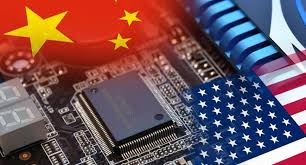As trade tensions continue to escalate between the United States and China, American consumers may soon feel the sting where it hurts most: their wallets. With the Biden administration continuing some of the protectionist policies started under former President Donald Trump, including massive tariffs on Chinese imports, everyday gadgets such as smartphones, laptops, smartwatches, and tablets could see noticeable price hikes and delays.
Below, we’ll break down the implications of these tariffs, the shift in manufacturing trends, the ripple effects of raw material shortages, and how everyday consumers may be impacted.

What Are These Tariffs, and Why Do They Matter?
The 245% Tariff Shock
A proposed or implemented 245% tariff on Chinese electronics imports is not just political posturing—it has real economic consequences. Electronics manufacturers rely heavily on China for everything from final assembly to essential components like chipsets, batteries, and displays. With such high import duties, companies face a dilemma: absorb the cost and shrink profit margins or pass it on to consumers.
Most brands will do a mix of both, but one thing’s for sure: electronics in the U.S. are getting more expensive.
How Much Will Prices Rise?
Even a 10-15% increase in production cost due to tariffs can make a big difference—especially for budget and mid-range products. A phone that previously cost $200 could jump by $30 or more. That may not seem like much, but for students or budget-conscious buyers, that price bump can be a dealbreaker.
The Shift Away from “Made in China”
China Plus One: The Manufacturing Migration
In response to trade tensions, major tech companies are adopting a “China Plus One” strategy—relocating portions of their production to other countries. Here’s how it’s playing out:
- Apple now assembles more iPhones in India.
- Dell and HP are moving laptop production to Vietnam and Mexico.
However, relocating production is a logistical nightmare. Setting up factories, training labor, and building new supply chains takes time and money. While some companies have made progress, full independence from Chinese manufacturing is still a long way off.
Are Other Countries Now in the Crosshairs?
Vietnam, once seen as a strong alternative, is also facing U.S. tariffs. This narrows options for manufacturers looking to diversify away from China. Some companies are considering Mexico or even small-scale U.S. production—both of which come with higher labor and operational costs.
Supply Delays and Regional Launches
Due to these complications, expect some gadgets to launch later in the U.S. or in limited quantities. Manufacturers may prioritize rollouts in Europe or Asia, where they can avoid the steep import fees.
Raw Material Shortages: The Silent Crisis
China’s Retaliation: Rare Earths Export Restrictions
China isn’t backing down. It’s using its dominance in rare earth elements as leverage. These include:
- Gallium – Used in chips and 5G radios
- Germanium – Crucial for fiber optics and IR sensors
- Antimony – Found in batteries and flame-retardant materials
By halting or limiting exports of these materials, China is tightening the screws on global electronics manufacturing.
Why Finding Alternatives Isn’t Easy
Rare earth mining and refinement are complex. Even if new mines are found, it takes years to ramp up production. Meanwhile, device makers face component shortages that could:
- Delay next-gen devices like AR/VR headsets, gaming phones, and 5G smartphones
- Lead to feature downgrades in upcoming product lines
What This Means for Consumers
Higher Prices Are Coming
Consumers in the U.S. should brace for increased prices on nearly all electronics—especially budget laptops, entry-level smartphones, and Chromebooks. A $500 laptop could easily become a $550-$600 model with the same specs.
Expect Fewer Choices and Delays
- Launch delays could make it harder to get the newest models at release.
- Some Chinese brands might skip the U.S. market altogether.
- Mid-range and low-cost devices may be produced in lower quantities.
Reduced Value for Money
With tighter margins, companies may opt to cut costs by:
- Using lower-quality components
- Reducing battery life
- Skipping premium features like high-refresh-rate displays or advanced cameras
This means consumers may pay more for less—a tough reality for students, remote workers, and families looking for value tech.
Is This the New Normal?
Unless there’s a significant policy shift or a trade agreement between the U.S. and China, the situation is unlikely to improve soon. The global tech supply chain is undergoing a transformation that will take years, not months, to stabilize.
Your next phone might be assembled in Mexico, its display sourced from South Korea, and its processor from a Taiwanese fab—but the combined costs of these efforts could push prices even higher.
FAQs
Q1: Why are electronics prices increasing in the U.S.?
A: Due to heavy tariffs on Chinese imports and supply chain disruptions, production costs have risen, forcing manufacturers to increase retail prices.
Q2: What gadgets are most affected by the tariffs?
A: Budget and mid-range smartphones, laptops, Chromebooks, and tablets are most vulnerable to price hikes and limited availability.
Q3: Are tech companies still manufacturing in China?
A: Many are shifting operations to other countries like India, Mexico, and Vietnam, but complete relocation takes time and investment.
Q4: What are rare earth materials, and why do they matter?
A: Rare earths like gallium and germanium are essential in producing semiconductors, 5G components, and batteries. China currently controls much of their supply.
Q5: Could this affect product launches in the U.S.?
A: Yes, some products may see delayed releases or limited stock in the U.S. due to tariff-related costs and logistics.




